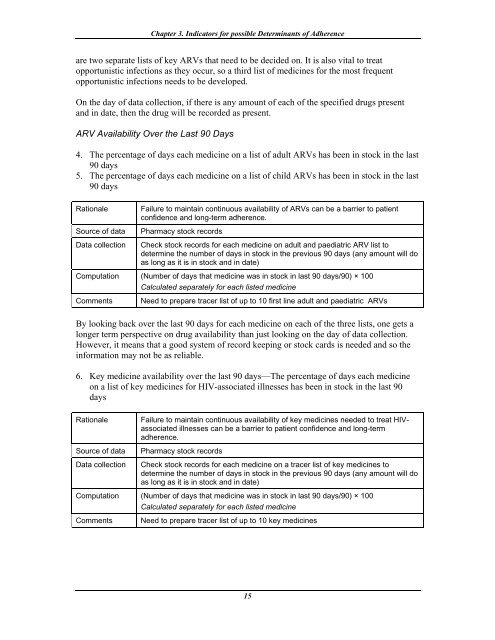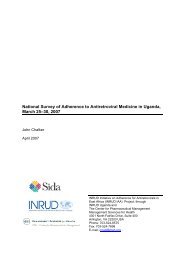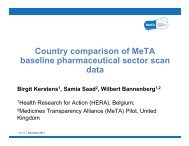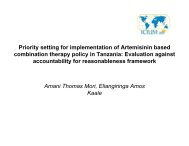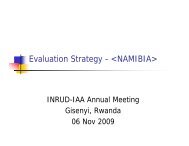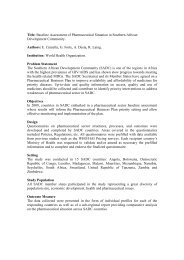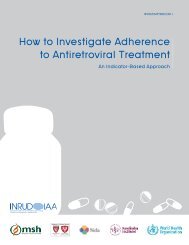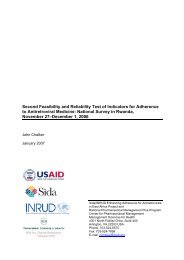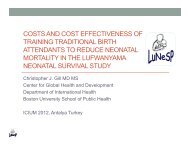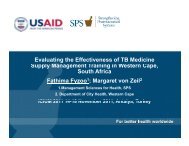How to investigate Adherence to Antiretroviral Treatment ... - INRUD
How to investigate Adherence to Antiretroviral Treatment ... - INRUD
How to investigate Adherence to Antiretroviral Treatment ... - INRUD
Create successful ePaper yourself
Turn your PDF publications into a flip-book with our unique Google optimized e-Paper software.
Chapter 3. Indica<strong>to</strong>rs for possible Determinants of <strong>Adherence</strong><br />
are two separate lists of key ARVs that need <strong>to</strong> be decided on. It is also vital <strong>to</strong> treat<br />
opportunistic infections as they occur, so a third list of medicines for the most frequent<br />
opportunistic infections needs <strong>to</strong> be developed.<br />
On the day of data collection, if there is any amount of each of the specified drugs present<br />
and in date, then the drug will be recorded as present.<br />
ARV Availability Over the Last 90 Days<br />
4. The percentage of days each medicine on a list of adult ARVs has been in s<strong>to</strong>ck in the last<br />
90 days<br />
5. The percentage of days each medicine on a list of child ARVs has been in s<strong>to</strong>ck in the last<br />
90 days<br />
Rationale<br />
Source of data<br />
Data collection<br />
Failure <strong>to</strong> maintain continuous availability of ARVs can be a barrier <strong>to</strong> patient<br />
confidence and long-term adherence.<br />
Pharmacy s<strong>to</strong>ck records<br />
Check s<strong>to</strong>ck records for each medicine on adult and paediatric ARV list <strong>to</strong><br />
determine the number of days in s<strong>to</strong>ck in the previous 90 days (any amount will do<br />
as long as it is in s<strong>to</strong>ck and in date)<br />
Computation (Number of days that medicine was in s<strong>to</strong>ck in last 90 days/90) × 100<br />
Calculated separately for each listed medicine<br />
Comments<br />
Need <strong>to</strong> prepare tracer list of up <strong>to</strong> 10 first line adult and paediatric ARVs<br />
By looking back over the last 90 days for each medicine on each of the three lists, one gets a<br />
longer term perspective on drug availability than just looking on the day of data collection.<br />
<strong>How</strong>ever, it means that a good system of record keeping or s<strong>to</strong>ck cards is needed and so the<br />
information may not be as reliable.<br />
6. Key medicine availability over the last 90 days—The percentage of days each medicine<br />
on a list of key medicines for HIV-associated illnesses has been in s<strong>to</strong>ck in the last 90<br />
days<br />
Rationale<br />
Source of data<br />
Data collection<br />
Failure <strong>to</strong> maintain continuous availability of key medicines needed <strong>to</strong> treat HIVassociated<br />
illnesses can be a barrier <strong>to</strong> patient confidence and long-term<br />
adherence.<br />
Pharmacy s<strong>to</strong>ck records<br />
Check s<strong>to</strong>ck records for each medicine on a tracer list of key medicines <strong>to</strong><br />
determine the number of days in s<strong>to</strong>ck in the previous 90 days (any amount will do<br />
as long as it is in s<strong>to</strong>ck and in date)<br />
Computation (Number of days that medicine was in s<strong>to</strong>ck in last 90 days/90) × 100<br />
Calculated separately for each listed medicine<br />
Comments<br />
Need <strong>to</strong> prepare tracer list of up <strong>to</strong> 10 key medicines<br />
15


